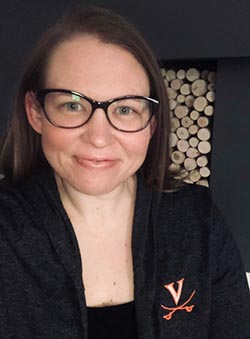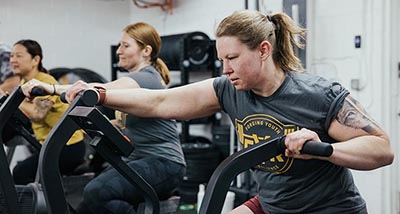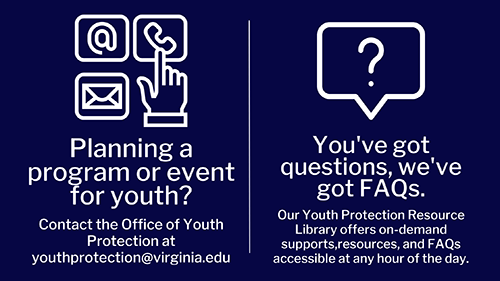Meet Carri Burgjohann, Office of Youth Protection Manager
In 2019, the UVA Office of Youth Protection was created to provide a centralized office for resource programs involving minors, and to provide processes, procedures, and assistance for youth programs to comply with applicable laws and policies, including the UVA Protection of Minors Policy. The online Youth Protection Training teaches learners to know how to identify potential abuse and prevent abuse within their program. The training also includes how program staff or volunteers should respond to a disclosure and the legal requirement and process for reporting suspected abuse/neglect.
 Meet Carri Burgjohann, Manager for the Office of Youth Protection. Carri was recently certified as Praesidium Guardian and, in addition to being a national board member for the Forging Youth Resilience organization, was also recently nominated to the national Higher Education Protection Network (HEPNet) Board of Directors. We asked her to explain her roles and the significance of her office's work to the UVA community.
Meet Carri Burgjohann, Manager for the Office of Youth Protection. Carri was recently certified as Praesidium Guardian and, in addition to being a national board member for the Forging Youth Resilience organization, was also recently nominated to the national Higher Education Protection Network (HEPNet) Board of Directors. We asked her to explain her roles and the significance of her office's work to the UVA community.
First, tell us why you do the work you do.
I work in youth protection because all youth deserve safe spaces where they can grow, be curious, learn, and find community.
The University serves 35,000+ youth in 150+ programs ranging from swimming or music lessons, athletic camps or mentoring programs which occur on Grounds, to overnight summer programs, international programs, and tournaments. Youth in programs come from the local Charlottesville community, across the United States, and we have a growing number of programs that include youth from other countries. When youth are in our space, we want them to have a safe and fun time so that the University is on their radar for the future as a place for education, employment, or as a great place to visit for an event. Their experience while in our spaces can be a direct reflection of the UVA brand and they share with their families and communities about their experience.
What are some of the challenges your group has identified within and beyond UVA, and how has your team been addressing them?
1 in 4 girls and 1 in 6 boys will be sexually abused before they turn 18 years old. Abuse can and does occur in a variety of settings such as in homes, youth programs, schools, and churches, and in recent years there have been several landmark cases in higher education settings.
There is an opportunity for youth programs to partner with families and caregivers and to provide them with tools to talk with youth about safety or how to identify situations or programs which may not be a good fit for their child. The Office of Youth Protection offers several of these resources in the Parent and Family Resources section of our Resource Library.
What is the most challenging part of your job?
Change takes time. It’s easy to get caught up in the day-to-day work and feel like nothing is changing and I often have to intentionally pause and recognize how far we have come in the last few years. I’m wired to spot risk and manage it immediately, and I’ve had to tune into where the true power for change exists—in relationship and community with the incredible people leading youth programs.
Is there one project you’ve been working on that you’re most proud of that directly benefits the UVA community?
In 2020 when I began in this role, we were tracking youth programs and compliance largely through spreadsheets and email records. To increase communication and access for youth programs to their compliance data, I developed our centralized youth program registration system with the support of our vendor, Ideal Logic. We now have over 3,100 users in the Youth Protection Portal. Building out a centralized youth program registration system has been a significant undertaking. The system captures youth programs and events in one place, tracks compliance with University Protection of Minors Policy requirements, and has increased cross-departmental communications and awareness of the presence of youth in many spaces. The central system and the data it produces tell the story of the youth we serve, the impact programs are having on the community, and act as a timely tool when an emergency arises and we need to know where children may be located.
Our Youth Protection Portal is designed to be a one-stop-shop and is self-service, so once a program is registered in the system, the program can monitor compliance with youth protection requirements in real time, see notification history, make updates to their program details, or add program staff.
I understand you were recently certified as the first Praesidium Guardian for UVA. Congratulations! What does this mean, and how does it benefit the UVA community?
The Praesidium Guardian certification was created to recognize individuals dedicated to preventing sexual abuse of vulnerable populations. In addition to robust training offered through the certification, I completed an Impact Project which was reviewed by Praesidium. The project became the updated online Youth Protection Training released in 2021. Certification benefits the UVA community because it keeps us connected to a national network of practitioners and experts, plugs us into current trends and prevention strategies across the industry, and supports the Office of Youth Protection in the consistent implementation of abuse prevention best practices.

(Photo on left: Carri working out with other Forging Youth Resilience (FYR) members (photo credit: Ryan Murphy). FYR empowers young people to build physical and mental strength for life by providing access to a network of community-based fitness programs and mentorship.)
How has your work with HEPNet been going since you joined the Board of Directors?
Joining the Board of HEPNet has increased my awareness of the need for youth protection across a variety of higher education institutions: community colleges, historically black colleges and universities, and small colleges with enrollment less than 5k that don’t always have the resources a larger state university has. I value having a voice in shaping an organization that is setting the standard in a space where a decade ago, there was no standard. I will be presenting at the national HEPNet Conference in October 2023.
What do you love about the work you do?
Hearing from programs! Communication is a gift and if programs are reaching out to us, asking for resources, asking questions, and even pushing back, it tells me they’re engaged and trying to figure out what youth protection looks like in their program.
How does your work align with UVA's 2030 Plan?
We’re strengthening the University’s foundation as youth program participants—who come from various backgrounds—might someday be our students.
We seek to be a good neighbor to the Charlottesville region by networking with partners such as Madison House, other central Virginia community youth-serving organizations, and with colleagues in the region including those in our athletics conference (Atlantic Coast Conference), our neighbors in Richmond at Virginia Commonwealth University, and Virginia Tech. These partnerships allow us all to raise the standard for youth protection.
We offer nimble and reliable systems which allow programs to carry out their mission while conveniently monitoring compliance with safety standards.
What do you envision for the Office of Youth Protection over the next 2-5 years?
I'd love to see growth in both scope and the team. As a former K-12 educator, I want to see the UVA Office of Youth Protection be a familiar name in K-12 school districts so they are aware of our standards for youth protection when they send high schoolers to intern with or shadow University faculty or staff, and so they know to contact us if they’re bringing students to Grounds for any reason so we can provide resources for them for a fun and safe visit. Or, if we have faculty, staff, or students going into the schools for mentoring or other programs, we’re able to work in partnership to promote safe environments for youth. I envision the growth of our systems and procedures to further align with industry best practices and ease some of the administrative burdens of operating a youth program.
What are some takeaways you would love your UVA colleagues to know about the work you do?
 We all get to play a role in protecting children. Sometimes the role is being aware of resources that can support children or families we know. Other times, it’s reporting suspected child abuse/neglect. Many individuals affiliated with the University are mandatory reporters under Virginia law. The Office of Youth Protection is here to support programs and departments/units around reporting obligations and collaborate with departments/units to determine how youth protection might interface with their work in other ways. The work I do alongside an incredible team of staff in the Department of Safety and Security supports the safety of all who share our space: faculty, staff, students, visitors, and youth.
We all get to play a role in protecting children. Sometimes the role is being aware of resources that can support children or families we know. Other times, it’s reporting suspected child abuse/neglect. Many individuals affiliated with the University are mandatory reporters under Virginia law. The Office of Youth Protection is here to support programs and departments/units around reporting obligations and collaborate with departments/units to determine how youth protection might interface with their work in other ways. The work I do alongside an incredible team of staff in the Department of Safety and Security supports the safety of all who share our space: faculty, staff, students, visitors, and youth.
